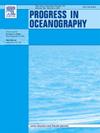伪鱼科(Pseudotanaidae,甲壳纲:tanaidae)的进化史及其系统复杂性的解读
IF 3.6
3区 地球科学
Q1 OCEANOGRAPHY
引用次数: 0
摘要
Pseudotanaidae (Tanaidacea)是深海甲壳类动物中具有重要生态学意义的一类,但由于分子数据有限,其系统发育关系仍未得到很好的解决。本研究整合了目标测序(COI, 18S)和有丝分裂基因组分析,重建了Pseudotanaidae的进化史。使用最大似然(ML)推断的系统发育树证实了该家族的单系性,同时揭示了Pseudotanais属内的多系性。样本个体之间的遗传差异与形态分组密切相关,表明存在不同的进化谱系。我们的研究极大地扩展了Pseudotanaidae的分子数据集,使公共数据库中COI和18S序列的数量增加了20多倍。此外,我们提出了第一个深海鲨鱼的有丝分裂基因组,揭示了独特的线粒体特征。值得注意的是,在典型的无脊椎动物线粒体翻译表中,它们都具有意想不到的TAA终止密码子重新分配给酪氨酸的特征。这些发现为未来的分类和进化研究建立了一个强有力的框架,强调需要扩大基因组采样来解决假假aidae系统发育中剩余的不确定性。本文章由计算机程序翻译,如有差异,请以英文原文为准。
Decoding the evolutionary history and systematic complexity of Pseudotanaidae (Crustacea: Tanaidacea)
The family Pseudotanaidae (Tanaidacea) comprises ecologically significant deep-sea crustacean taxa, yet its phylogenetic relationships remain poorly resolved due to limited molecular data. This study integrates targeted sequencing (COI, 18S) and mitogenomic analyses to reconstruct the evolutionary history of Pseudotanaidae. Phylogenetic trees inferred using Maximum Likelihood (ML) confirm the monophyly of the family while revealing polyphyly within the genus Pseudotanais. Genetic divergence among sampled individuals corresponds closely with morphological groupings, indicating the presence of distinct evolutionary lineages. Our study significantly expands the molecular dataset for Pseudotanaidae, increasing the number of COI and 18S sequences in public databases more than twentyfold. Furthermore, we present the first mitogenomes of deep-sea tanaids, revealing unique mitochondrial features. Notably they all feature an unexpected reassignment of the TAA stop codon to tyrosine, in the otherwise typical invertebrate mitochondrial translation table. These findings establish a robust framework for future taxonomic and evolutionary studies, emphasizing the need for expanded genomic sampling to resolve remaining uncertainties in Pseudotanaidae phylogeny.
求助全文
通过发布文献求助,成功后即可免费获取论文全文。
去求助
来源期刊

Progress in Oceanography
地学-海洋学
CiteScore
7.20
自引率
4.90%
发文量
138
审稿时长
3 months
期刊介绍:
Progress in Oceanography publishes the longer, more comprehensive papers that most oceanographers feel are necessary, on occasion, to do justice to their work. Contributions are generally either a review of an aspect of oceanography or a treatise on an expanding oceanographic subject. The articles cover the entire spectrum of disciplines within the science of oceanography. Occasionally volumes are devoted to collections of papers and conference proceedings of exceptional interest. Essential reading for all oceanographers.
 求助内容:
求助内容: 应助结果提醒方式:
应助结果提醒方式:


